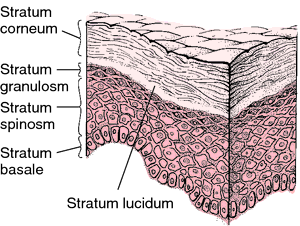Medical term:
Epidermis
epidermis
[ep″ĭ-der´mis] (pl. epider´mides) (Gr.)the outermost and nonvascular layer of the skin, derived from the embryonic ectoderm, varying in thickness from 0.07 to 1.4 mm. On the palmar and plantar surfaces it comprises, from within outward, five layers: (1) basal layer (stratum basale), composed of columnar cells arranged perpendicularly; (2) prickle-cell or spinous layer (stratum spinosum), composed of flattened polyhedral cells with short processes or spines; (3) granular layer (stratum granulosum), composed of flattened granular cells; (4) clear layer (stratum lucidum), composed of several layers of clear, transparent cells in which the nuclei are indistinct or absent; and (5) horny layer (stratum corneum), composed of flattened, cornified, non-nucleated cells. In the epidermis of the general body surface, the clear layer is usually absent. adj., adj epider´mal, epider´mic.

Section of epidermis. From Dorland's, 2000.
Miller-Keane Encyclopedia and Dictionary of Medicine, Nursing, and Allied Health, Seventh Edition. © 2003 by Saunders, an imprint of Elsevier, Inc. All rights reserved.
ep·i·der·mis
, pl.ep·i·derm·i·des
(ep'i-dĕrm'is, -derm'i-dēz), [TA]1. The superficial epithelial portion of the skin (cutis). The thick epidermis of the palms and soles contains the following strata, from the surface: stratum corneum (keratin layer), stratum lucidum (clear layer), stratum granulosum (granular layer), stratum spinosum (prickle cell layer), and stratum basale (basal cell layer); in other parts of the body, the stratum lucidum and stratum granulosum may be absent.
2. In botany, the outermost layer of cells in leaves and the young parts of plants.
Synonym(s): cuticle (3) , cuticula (2) , epiderm, epiderma
[G. epidermis, the outer skin, fr. epi, on, + derma, skin]
Farlex Partner Medical Dictionary © Farlex 2012
epidermis
(ĕp′ĭ-dûr′mĭs)n.
1. The outer, protective, nonvascular layer of the skin of vertebrates, covering the dermis.
2. An integument or outer layer of various invertebrates.
3. The outermost layer of cells covering the leaves and young parts of a plant.
ep′i·der′mal (-məl), ep′i·der′mic adj.
The American Heritage® Medical Dictionary Copyright © 2007, 2004 by Houghton Mifflin Company. Published by Houghton Mifflin Company. All rights reserved.
ep·i·der·mis
, pl. epidermides (epi-dĕrmis, -mi-dēz)1. The superficial epithelial portion of the skin (cutis). The epidermis of the palms and soles has the following strata: stratum corneum (horny layer), stratum lucidum (clear layer), stratum granulosum (granular layer), stratum spinosum (prickle cell layer), and stratum basale (basal cell layer); in other parts of the body, the stratum lucidum may be absent.
2. botany The outermost layer of cells in leaves and the young parts of plants.
Synonym(s): cuticle (3) , cuticula (2) .
Synonym(s): cuticle (3) , cuticula (2) .
[G. epidermis, the outer skin, fr. epi, on, + derma, skin]
Medical Dictionary for the Health Professions and Nursing © Farlex 2012
epidermis
The structurally simple outermost layer of the skin, containing no nerves, blood vessels, or hair follicles, and acting as a rapidly replaceable surface. The deepest layer of the epidermis is the basal cell layer. Above this is the ‘prickle cell’ layer. The epidermis is ‘stratified’, the layers of cells becoming flatter towards the surface. The outermost cells of the epidermis are dead and are continuously shed.Collins Dictionary of Medicine © Robert M. Youngson 2004, 2005
epidermis
- (in plants) the thin tissue, usually one cell thick, that surrounds young roots, stems and leaves. In stems and leaves the epidermal cells secrete a CUTICLE (1), in roots they do not. In older roots and stems the epidermis is often replaced by CORK tissue.
- (in animals) the outer layer of the skin derived from embryonic ECTODERM. In vertebrates, the epidermal layer is usually made up of stratified EPITHELIUM with an outer layer of dead cells which become ‘keratinized’ (see KERATIN forming a protective layer. The invertebrate epidermis is normally one cell thick and often forms a protective cuticle.
Collins Dictionary of Biology, 3rd ed. © W. G. Hale, V. A. Saunders, J. P. Margham 2005
Epidermis
The outer layer of skin, consisting of a layer of dead cells that perform a protective function and a second layer of dividing cells.
Mentioned in: Burns, Epidermolysis Bullosa, Malignant Melanoma, Skin Grafting, Staphylococcal Scalded Skin Syndrome, Toxic Epidermal Necrolysis, Warts
Gale Encyclopedia of Medicine. Copyright 2008 The Gale Group, Inc. All rights reserved.
ep·i·der·mis
, pl. epidermides (epi-dĕrmis, -mi-dēz)[TA] The superficial epithelial portion of the skin (cutis).
[G. epidermis, the outer skin, fr. epi, on, + derma, skin]
Medical Dictionary for the Dental Professions © Farlex 2012
Latest Searches:
anteorbital - Anorgasmy - anociassociation - ankerite - anitrogenous - anhydration - angiectomy - androgenesis - anconal - anatomical - anachoresis - amphigony - ammonification - aminometramide - aminolevulinic - ameburia - ameboma - ambitendencies - alternifolia - alopecia -
- Service manuals - MBI Corp